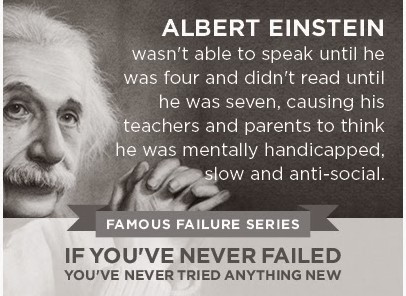Failure is the Greatest Teacher of All… Learn from It! 🙂
Tag Archives: esl
Conquering that Prestigious 2nd Language
Learning a new language can be an exciting opportunity to expand your skill set, improve your mental abilities, and provide new travel or job opportunities not to mention and opening up communications with an entire country of people. So why do so many hold back on learning that essential second language? With programs like Rosetta Stone and Pimsleur, students have access more resources than ever and yet, the numbers of bilingual speakers are declining steadily. A recent survey has shown that only 53% of Europeans can converse in a second language while only 18% of Americans speak a language other than English.
I’ve listed down a few steps that I feel are necessary to learning a second language fast and I share the se steps when any ambitious ESL student wants me to make them fluent in 3 months… while that might be possible for some, most of us will actually have to devote precious time, energy and brain power into conquering that prestigious 2nd language.
se steps when any ambitious ESL student wants me to make them fluent in 3 months… while that might be possible for some, most of us will actually have to devote precious time, energy and brain power into conquering that prestigious 2nd language.
Step 1. Learn key vocabulary words
Each language has a set of words that are used more commonly that others. For instance, just 300 English words make up 65% of all written material. Identify the key words in your target language and tackle a few each day using pictures, flashcards, and apps. These words will make up the sentences and questions you will create to communicate with others. Take the time to learn these words by heart and commit them to memory, these words will be key to unlocking the secret sentences of the Spanish, French, Chinese and all others.
Step 2. Find the similarities and differences between your native language and your target language
For example, Both French and English use the same Subject-Verb-Object syntax so “He likes apples” translates to “Il aime les pommes”. Once you understand the basic sentence pattern, you can begin to substitute your key vocabulary words to make new sentences – “Il aime les oranges” – and even expand on them to create more complex sentences: “Il aimes les oranges et les pommes”
Step 3. Learn in proactively and in phrases
Rather than learning how to use the present simple and then practicing it in sentences, look at several present simple sentences and try to discover the pattern for yourself. Example: “J’aime les pommes, Il aime les pommes, Ils aiment les pommes” – notice how the verb changes with the subject. Try to learn by discovering the rules for yourself, when you’ve figured out a rule, test it with other examples to see if it works. Continue to collect examples and adapt your rules based on what you learn. By doing this, you are not only memorizing a rule, but actively discovering it which will help you to retain it longer.
List down some of the phrases that will be most useful to you and learn these first. If you’re travelling in a new country these would be questions like: “Where is the pub? How much does it cost? Which way to the bathroom?” etc..
Step 4. Engage all of your senses in the learning process
 How you approach learning determines how well and how fast you will learn. If you only practice reading and writing, you will find yourself sadly incapable of communicating one-on-one with a native speaker. Instead, take a multi-faceted approach and commit yourself to truly immersing in your target language as if it were your native language. Think about everything we use our native language for: to watch television, listen to the news, read magazines, sing songs, and chat with friends. Exposing yourself to a new language in a variety of different settings will give you the opportunity to see the langauge in action.
How you approach learning determines how well and how fast you will learn. If you only practice reading and writing, you will find yourself sadly incapable of communicating one-on-one with a native speaker. Instead, take a multi-faceted approach and commit yourself to truly immersing in your target language as if it were your native language. Think about everything we use our native language for: to watch television, listen to the news, read magazines, sing songs, and chat with friends. Exposing yourself to a new language in a variety of different settings will give you the opportunity to see the langauge in action.
Step 5. Practice properly and frequently
The popular idea that ‘practice makes perfect’ is admirable but misleading. Practice doesn’t make perfect – perfect practice makes perfect. If you want to converse fluently in any language, it is essential to actually talk with native speakers during your learning process, not after. There are many websites and resources available that put you in touch with native speakers for free or very low costs. Skpye, italki, duolingo, google translate, are just a few of the many wonderful tools available to language learners today. Participate in language-exchange programs and make friends with the people whose language you wish to learn. In doing so, you’ll force yourself to USE the grammar you’ve learned and gain important feedback on your skills.
Step 6. Set clear and realistic goals
Before attempting a new language, ask yourself why you want to learn and what level of fluency you hope to achieve. Are you learning for travel purposes, work, or simply to be able to communicate with the locals in your area? Decide your main objective first and then consider the level of grammar and vocabulary needed, taking into account the amount of time you are willing to commit. For example: If you are learning for travel purposes, simple expressions such as: “Which way to the train station? How much does it cost?” and “Thanks, it was delicious.” will be a necessary part of your study plan. Past perfect tenses and conditional clauses should probably be left alone. Once you have your list and objectives laid out, make yourself a study plan and set milestones to motivate and track your progress.
Hope this helps and remember, you are never too old to start learning new things!
